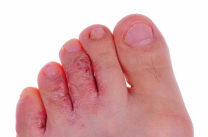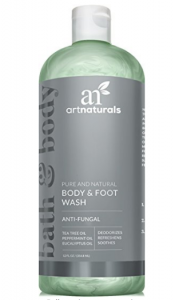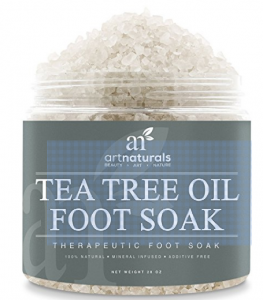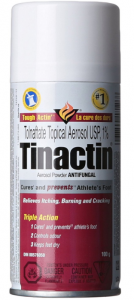Athlete Foot Treatment with Essential Oils

Athlete’s foot is a common condition that affects about 1 in 10 people.
Men are more likely to have this condition and about half of the people that have it will have recurring rashes because the fungus can survive in the cracks between the toes.
This type of fungus is called tinea and flourishes in moist and warm environments, it tends to show up in shower rooms, on locker room floors and near swimming pools.
Since these are areas where people step around in their bare feet, the tinea fungus is easily spread in moist environments where people share facilities.
Athlete’s foot is a common condition because our feet sweat and are contained in socks and shoes for most of the day, this can create a moist environment that fungus loves to grow in.
Symptoms Athlete Foot
Some of the most common symptoms of athlete’s foot involve itchy skin between the toes and on the bottom of your feet.
You may also feel a stinging and burning sensation in those same areas.
The feet may form blisters that add to the itchy skin sensations.
A skin rash will form that resembles tiny red blisters and you may have a bad foot odour.
The skin on your foot will likely begin to form cracks, and the skin will start to peel in the same areas as the itchy skin.
Your skin may feel raw and dry in addition to being very itchy and scaly.
Finally, a toenail fungus may develop, causing your toenails to become discoloured, thickened and very dry. Your toenails may start to pull up from the nail bed as a result of the toenail fungus.
Athlete Foot Diagnosis
A doctor can diagnose your athlete’s foot with a few simple observations and perhaps a skin test. A skin test can be performed to ensure you have a fungal infection and that you get the appropriate treatment.
This test involves the doctor scraping off a small bit of the skin that is troublesome and placing it in a potassium hydroxide solution that will kill off normal skin cells and leave the fungus behind to be studied under a microscope.
Treatment for Athlete Foot
You can treat athlete’s foot in a few different ways. There are over-the-counter anti-fungal and antiseptic medications that you can apply directly to your foot.
Your doctor can also prescribe medication for you that are strong, topical anti-fungal agents, steroids to reduce inflammation and/or antibiotics, if the rawness and blistering has caused your feet to become infected.
Another way to treat athlete’s foot is a more natural method that is simpler and less expensive in the long run. You can treat this ailment by using natural essential oils and other home-based remedies.
Natural Remedies for Athlete Foot
You can begin treatment by soaking your feet in salted water or a solution of vinegar and water to help dry up the blisters that have formed and reduce the itching.
A tried and true natural treatment for athlete’s foot is the use of essential oils
Essential Oils used to treat this condition are:
Lavender Oil – for its anti-fungal, anti-microbial, healing and soothing properties
Tea Tree Oil – has extremely powerful anti-fungal and antiseptic properties using this oil along with Lavender Oil will make an excellent treatment for this condition.
Geranium Oil – also has anti-fungal and antiseptic properties helping to fight bacteria.
Myrrh – has anti-fungal properties, but is the best oil to help with dry, cracking skin. Myrrh works well on Athlete’s foot when combined with Lavender Oil.
Peppermint Oil – will help with the odour associated with Athlete’s foot, it will also help fight the fungal infection, stimulates blood circulation and will help relieve the itch.
Peppermint oil works really well when combined with Lavender and Tea Tree Oils.
Now how to use these essential oils for treating your Athlete’s foot. The first thing I would recommend is washing your feet daily with a mild Tea Tree Soap, being sure to dry your feet off well afterwards, especially in-between the toes.
Essential Oil Athlete Foot Recipe
- Combine equal amounts of Tea Tree, Lavender and Peppermint Essential Oils
- put on affected area 3-4 times a day.
- This mixture can be added to a small amount of olive oil or other carrier oil and massaged into the feet.
- Be sure to really get in-between the toes.
After a week or so of this your feet should be cleared of this rash. Depending of course on how bad the outbreak was to begin with.
Other treatments for Athlete’s foot are:
The use of grapefruit seed extract. You may apply this extract to your feet two to three times a day. Incorporating more garlic in your diet can also help, as garlic is a natural anti-fungal agent.
Foot Bath Recipe #1
- two tablespoons of Himalayan crystal salts
- four ounces of organic apple cider vinegar
- warm water
Soak in a foot bath and it will create an acidic soak that kills fungus.
You can also apply this solution directly to your feet and wipe the inside of your shoes with it to rid of the fungus.
Foot Bath Recipe #2
- Prepare a tea, mixing ½ cup of oregano leaves.
- Use the mixture to soak your feet two to three times a day
- Be sure to make a fresh batch of tea each time.
Coconut oil can be applied to the feet for anti-fungal effects.
Tips to Avoid Getting Athlete Foot
To keep athlete foot at bay by:
- keeping your feet dry and when at home take your shoes off and expose your feet to the air.
- Try not to wear nylon socks.
- Wear breathable, preferably organic, cotton socks and be sure to change them on a daily basis.
- After your feet become wet, whether its after a shower or bath or especially after using a public shower, dry your feet completely.
- Pay careful attention to drying the areas between your toes.
- If you have been wearing old, worn out training footwear, invest in a new pair.
- Also, do not wear other people’s shoes, as athlete’s foot is contagious.
- Another good tip is to wear sandals as much as possible to keep your feet exposed to sunlight and fresh air. This will help keep moisture away, the environment in which athlete’s foot thrives.
- If your feet sweat a lot inside your shoes and socks, try not to wear the same shoe two days in a row. Instead, give shoes a chance to thoroughly air out.
- Sleeping barefoot with your feet outside or your bed cover will also help keep fungus at bay.
- Keep your toenails trimmed short so the fungus doesn’t have a comfortable place to live.
It’s also a good idea to sprinkle cornstarch or baking soda between your toes before putting on your shoes and socks. This will absorb moisture and help eliminate foot odour, which can accompany athlete’s foot.
Tea Tree Oil has been used for many years as an antibacterial and antiseptic.
Psoriasis is a non-contagious chronic skin condition – there are ways to naturally help this condition
Harmful chemicals that can be found in skin care products
Some products that can be helpful with Athletes Foot
© 2017 – 2024, Tes. All rights reserved.



Ouch, the athlete’s foot really does look like a pain to deal with. I bet people who’s feet sweat a lot will have an even higher chance of catching it. It just provides too ideal of an environment to the fungus. I like the essential oil idea, because that’s really good at killing harmful stuff that’s trying to attack the body. It also smells nice. I don’t know anyone athlete’s foot but if I know, I would recommend them to check out your stuff.
Hi Win Bill thanks for your comments and stopping by my website. Essential Oils can be so helpful for many things. Natures medicine.
My toes itch inbetween but I’ve got no other symptoms. Do I still have athete’s foot or not. I need to know ASAP. My skin is not dry and my toes don’t hurt. Just itch
Hi, an itch inbetween toes can be athletes foot, but it can also be an allergy to laundry soap or caused by other things. To be sure it is best to get a doctor or podiatrist to check them out.